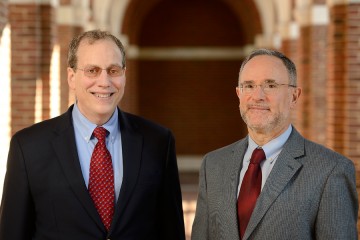When researchers try to uncover the cause of disease, they commonly start with two questions: Did a quirk in the patient's genes open the door to illness? Did exposure to environmental factors play havoc with the patient's health?

Image caption: Andrew Feinberg
Very often, both troublemakers are at least partly to blame. To provide the most effective treatment, doctors need to know as much as possible about how these partners in sickness and poor health work together.
Scientists from Johns Hopkins University and Texas A&M University have launched an ambitious new effort to gather such knowledge, with support from a $5.3 million National Institutes of Health grant. The team's goal is to learn at a fundamental level how genes and environmental factors interact to cause human disease.
The project is being led by Andrew Feinberg, Bloomberg Distinguished Professor and director of the Center for Epigenetics at Johns Hopkins, and David Threadgill, professor and chair of genetics at the Texas A&M College of Medicine and director of the Institute for Genome Sciences and Society at Texas A&M's College of Veterinary Medicine & Biomedical Sciences.
Two NIH units—the National Human Genome Research Institute and the National Institute of Environmental Health Sciences—will provide the funding over a five-year period. Support from these two sources reflects the project's dual research threads.
"Human disease is not purely genetic or environmental," Feinberg said. "So we are using controlled exposure and controlled genetics in mice—in ways we can never do in humans—to find out how environmental factors like lead exposure and diet cause disease. This should allow us to understand how genes and the environment co-conspire to cause illness."
Epigenetics is the study of genetic activity changes that occur without alteration of the basic DNA sequences. Sometimes, epigenetic changes triggered by environmental factors lead to serious health problems. As a first step toward averting or treating such illnesses, researchers need to figure out precisely how this process unfolds.
"The environment is perhaps the major contributor to human disease, yet its effect is virtually impossible to control for in human genetic studies," Feinberg said. "One example of how this team will try to get around this problem is by studying a very genetically diverse set of mouse strains and an environmental issue that is important to many people: exposure to lead and how it is linked to significant health and behavioral issues."
Feinberg said the team will use advanced genomic and mathematical methods to gather data and relate these findings directly to human disease population studies in order to understand how our distinct genomes and individual exposures to environmental factors affect human health.
"We are using epigenetic information," he said, "to understand how genes and environment connect as information that reprograms our bodies in early development to behave in a healthy or unhealthy way, and how it sets us up for adverse responses to stressors later in life. In particular, we are studying lead exposure in the mouse model and then will connect these results to a large group of urban lead-exposed people in Baltimore and the behavioral effects this exposure causes."
Feinberg's research in Baltimore will draw on expertise from Johns Hopkins University's School of Medicine, Whiting School of Engineering, and Bloomberg School of Public Health.
At Texas A&M University, Threadgill will supervise the portions of the research focusing on genetics and clinical phenotyping in the animal models. "My research group has a long-standing interest in how environmental exposures, such as chemicals and diet, interact with our genetics to impact future health and disease and, importantly, how this knowledge can be used to reduce the health impacts of detrimental environmental exposures," he said. "We hope that this work will lay the foundation for understanding the mechanisms by which the environment alters our health and to identify interventions that can reduce the negative impacts of disease."
Posted in Health, Science+Technology
Tagged andrew feinberg, epigenetics










